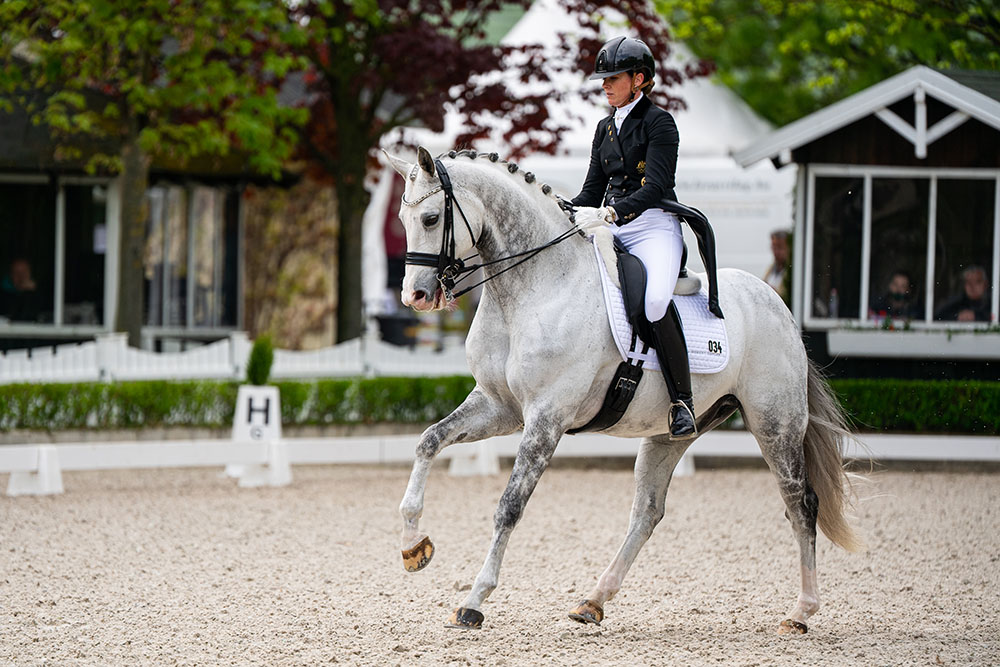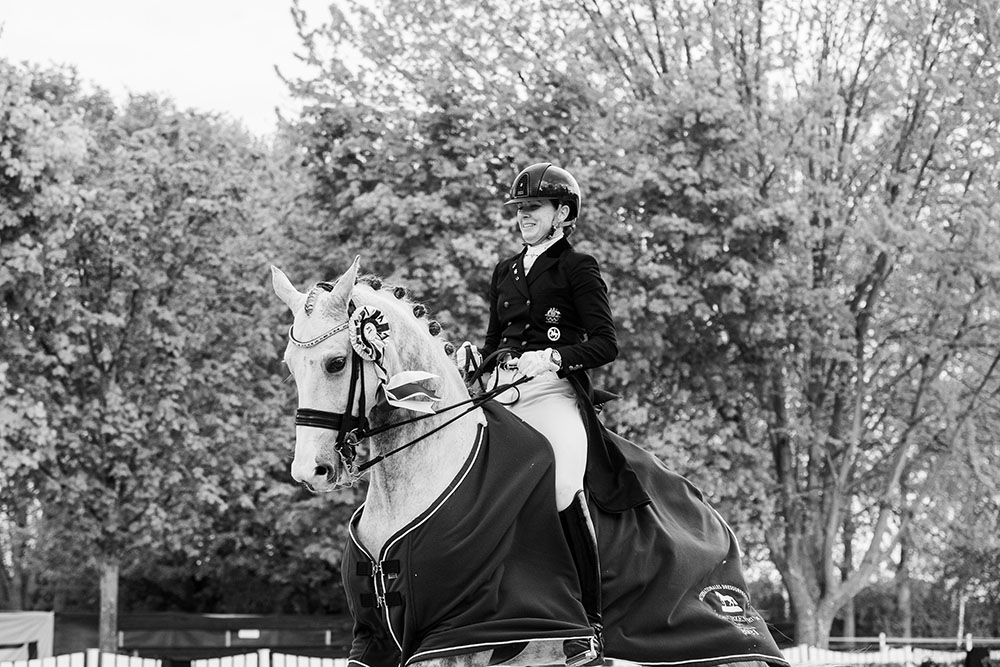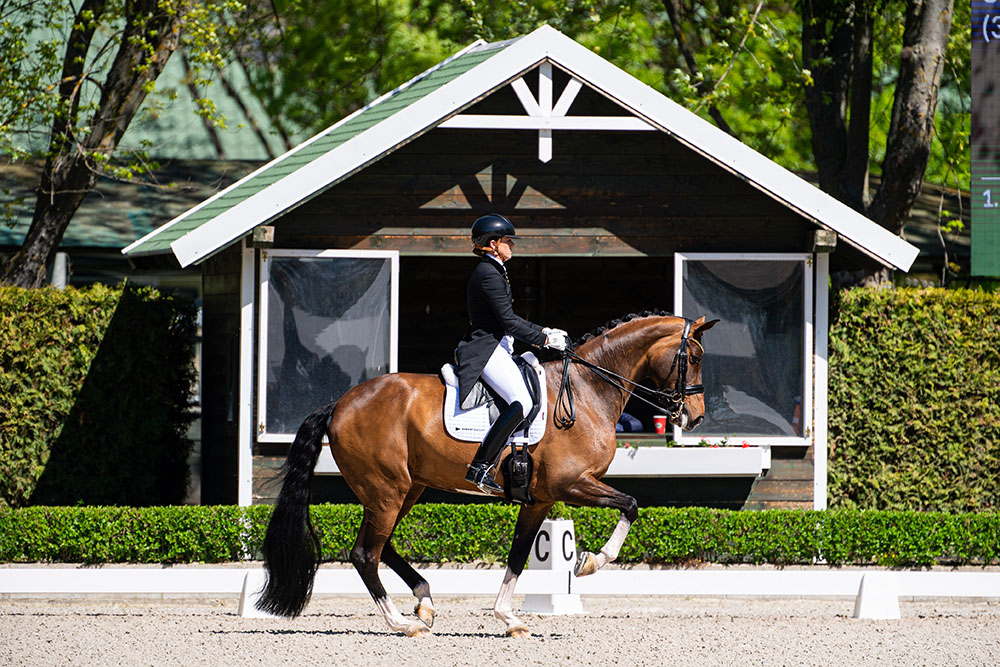With two horses in contention for next year’s World Championships in Herning, Lyndal Oatley is working hard to ensure they are both the best they can be. We find out more about her talented duo, and also discover Lyndal’s thoughts on dressage’s progress in Australia.

“I was really scared!
Thank you to Ulli Kasselmann
for saving my butt that day.”
With winter blanketing Europe, Aussie dressage rider Lyndal Oatley is in her puffer jacket and bracing for a brisk German morning that only Australians in the coldest parts of our country might understand. Not that she’s complaining; with two promising Grand Prix horses in work and a possible World Championships on the horizon, Lyndal’s feeling luckier than ever.
“I’m incredibly lucky to have two horses to compete with at Grand Prix. It has been a long journey, albeit a different journey, with both horses. They are polar opposites,” she explains. “Eros and Elvive are owned by my parents, Carol and Andrew – they are the best supporters ever!” Both horses have produced a string of impressive scores in recent months, and what’s more exciting is that it seems the best is still to come from both.
Eros, aka Ross, is a 12-year-old grey KWPN gelding by Sir Oldenburg (Sion) out of Selva (Olympic Ferro) and, as Lyndal explains, he has an interesting history. “Eros started as an eventer, which I can understand as he’s quite forward thinking at times and brave in some ways. A partially blind para rider from France bought him and competed him as a young horse; he wasn’t the easiest horse for her and so he was sent to Holland to sell. We found him on a video from a friend of ours, and at that point I had just had Ems [Lyndal Oatley and Patrik Kittel’s now three-year-old daughter, Emilia] and I wanted to find a horse that I could compete on at Grand Prix, but wasn’t finished yet.
“Ross was only doing Inter II at that point, and I thought he’d be a good horse to produce and develop, and just see where things go. I had an instant connection with him. A couple of years later we’re cranking it up, finally; it’s been a long road. Every horse has their strengths and weaknesses. With him, I really had to learn that. He’s naturally a bit shorter in the neck and he’s a bit of a pony; he’s a bit cheeky and he can explode, despite his cute little unicorn persona.”
An example of Ross exploding was during the presentations at Ludwigsburg CDI4* in September, where the pair finished third in the Grand Prix on 72.717% and fourth in the Freestyle on 75.875%, their best international Big Tour scores to date. The cute little unicorn took offence to the applauding crowd – something he’d not been exposed to before with Covid restrictions – and he bolted. “I was really scared! Thank you to Ulli Kasselmann for saving my butt that day,” says Lyndal, who can laugh about it now. “I have to learn to get him to cope with more pressure and noise; he doesn’t cope with that very well.” Since then, the pair have competed at Herning CDI3*, finishing third in both the Grand Prix and the Special with scores of 71.174% and 71.277%.
Elvive, aka Ellie, is a 12-year-old bay KWPN mare by Tuschinski (Krack C) out of Adonnee De Jeu (Blue Hors Don Schufro). Interestingly, she has a half-sister out of the same dam named Flanell, who’s competing with German rider Semmieke Rothenberger in the Under-25 Big Tour classes – recently scoring 81.955% in a Freestyle.
“Elvive is a dancer. She’s just a freak of nature. I know how lucky I am every day to sit on her and how exceptionally talented she is,” says Lyndal. “I bought her when she was seven; she was very much a diamond in the rough that had a lot of potential, and we thought, ‘let’s try her’. It’s been such a long journey – we had one setback where she fell over and needed time out – but after that we’ve never looked back and she’s feeling amazing. And now she’s really so developed.”
Lyndal explains that she’s now coming to a tricky part in the training of Elvive; after four international Big Tour shows, everything has been going well. “It’s at this point that you then start thinking, ‘how much should I push her, how much expression do I ask for, how much time do I spend warming up, where am I aiming for now?’ You can lose the balance between what you’re aiming for and what you really can achieve.”

WORKING THROUGH HICCUPS
At their most recent show, the CDI3* Blue Hors Dressurfestival in Denmark, Lyndal explains that she didn’t have the best test in the Grand Prix with Ellie. Even though they scored 70.565% for fifth place, it was their lowest international Grand Prix score so far – well behind their 73.718% personal best achieved at Donaueschingen CDI3* in Germany in August.
“At Blue Hors I rode terribly in the Grand Prix. It wasn’t a bad score, but for a horse like her it’s not relative to where she can be.” Lyndal explains that it was the mare’s first indoor show, and she didn’t quite get the balance right with the warm-up. “I gave her the same warm-up as I did my last show. But in this situation when it’s freezing cold outside, and I haven’t been able to give her the work in the morning because the arenas are not as open as normal outdoor competitions, it wasn’t enough.
“I went in [to the Grand Prix test] and my personal experience was she lifted her head, because everybody’s at eyesight. Now, with Ross I’d be like, ‘Yes, this is great, his head is up and his neck’s a bit more out’, but Elvive doesn’t need to do that. I need to keep her a little bit more through. Consequently, I didn’t have her through enough and the whole thing was off the bit for a large portion of it. And then because of that there was tension and I made a lot of mistakes. “She’s very sensitive, in a good way – she offers you the world – but she’s not experienced yet. Everything she does, she does with a lot of power. So if tension comes in, then it can look a bit stressed.”
Following a disappointing test, Lyndal – who says she’s her own biggest critic – had to regroup the next day for the Freestyle. She reluctantly watched the video of her test, which she found hard but knew was important from a learning perspective. “You have to kick yourself in the butt, and then you reassess, and you change what you can in a short period of time.
“I never like to let my horses down. I’ve always ridden not for myself, but to do the best I can for them on that day. And I knew I didn’t do that in the Grand Prix with Elvive. So I knew that the best thing I could do for her was to do better. The moment I got on before the Freestyle I had a different perspective. I went in to give us confidence again, because I wanted it to be a smooth test. I just really stayed focused and put the Grand Prix test out of my head.” Lyndal rode for slightly longer on the morning of the Freestyle, and rode more lines from her test to prepare; they won with 76.855% and it was Elvive’s best international Big Tour score to date.
“I was relieved!” says Lyndal of her feeling post-test. “You learn from these things. Sometimes you can’t predict how a horse is going to react or how the experience is going to be. In this situation I had to learn from it quickly. But that’s what we do and then that’s what makes us better.”
Interestingly, even at big competitions Lyndal likes to plait up her own horses as she finds this an important part of her preparation. “I like that one hour; I like that time to play with the horse and really know where they are mentally. It makes me feel connected with them before I start.”
Lyndal believes that Elvive doesn’t really have any weaknesses, but that doesn’t mean there isn’t anything to work on and improve. “She has a walk for a 10, and I know that when tension comes into the test, I lose that. So I want to work on that a little bit at the moment. Everything else is feeling very good.
“She can switch on and off very quickly. But if you switch her on too far, then the adrenaline comes in. I’m going to start practising just the first few lines before the walk and create a little bit more power in that passage. And then try and go into the walk and then use a lot of repetitious aids like a halt and just waiting, a bit of leg-yielding using the walk on a curved line, that sort of thing. Because if I can increase the adrenaline before the walk and learn how to turn it back down for that, then it’ll work and I’ll be fine.”
Lyndal says her two horses couldn’t be more different. “Ross, you sort of push him together and create him and it’s fun and like riding a little pony. With Ellie, less is more; after riding Ross this is something that takes a bit of skill that I’m still developing. I’ve never ridden a horse like her in my life and might not ever again, so I need to learn to just let her do her job and me be encouraging to that. When I learn that a little bit better… then yeah, it’s on!”
On the topic of horses, Lyndal says her husband, Swede Patrik Kittel, has a very exciting team of his own. He still has his two proven Grand Prix stars, Delaunay and Well Done de la Roche, as well as some up-and-coming horses – one in particular Lyndal says to keep an eye on. “Patrik has the most amazing gelding, Touchdown, who debuted winning with over 80% internationally. That’s a medal horse. For me, he has no weakness, and he’s just an exceptional horse.”
Exciting performances from the couple’s horses haven’t been the only thing to cheer about; Patrik’s long-time groom, Marie Johansson, recently took out the FEI Best Groom Award in recognition of her dedication. “The best grooms out there, they sacrifice their whole lives for these horses and riders. Marie is the perfect example of that. She’s been with Patrik longer than I have, and she’s basically my sister,” says Lyndal.

“I’m obsessed with Freestyles.”
FANATICAL ABOUT FREESTYLES
It’s no secret that Lyndal loves riding Freestyles, and it certainly looks like she’s put together great tests for both horses that have been well received by judges so far. “I’m obsessed with Freestyles and I’m obsessed with lines!” she says.
At the moment, there are two different ways Freestyles are scored – either with or without the FEI’s Degree of Difficulty system. As Lyndal explains, this can make things interesting. “Some shows, such as World Cups, are using the Degree of Difficulty system while other shows aren’t. You design a Freestyle for the highest degree of difficulty you can; Ross’ and Ellie’s Freestyles are both a 9.6 degree of difficulty if I do everything. However, I’ve found that the last two shows (where the FEI’s system was not used) – and this is no disrespect, but this just shows the situation that we’re dealing with at the moment – I got a 7 for Ross’ degree of difficulty from one judge, and then at another show I got an 8.8 from some judges but also 7.5 from other judges.”
Lyndal explains that when the FEI’s scoring system is used, judges essentially tick a box each time a movement is completed and the degree of difficulty is calculated. Without it, the scoring is more subjective – and usually harder to achieve a higher score. “It’s actually really interesting… you can’t really compare Freestyles at the moment unless they’re at the same show. It’s quite strange.”
Lyndal says she is a fan of the FEI’s system. “I’ve worked my butt off trying to make the test hard enough but still look easy… I want the points! It makes it really interesting because you know that if you do a test that’s hard and you can pull it off, then you can get a 9.6, that pushes you and that gives you a bit of incentive. I think the system is great.”

“Australians… we could make
a monkey do Grand Prix
if we wanted to.”
HERNING & BEYOND
In terms of yet-to-be-released selection criteria for the World Championships (formerly the World Equestrian Games) in Herning in 2022, Lyndal says she’ll take it as it comes and just continue working away with both horses; what will be, will be. While Europe certainly has a broader range of FEI competitions to choose from compared to Australia in terms of gaining qualifications for Herning, Lyndal says that right now it’s not quite as easy as you might think to find events.
“A few competitions are being cancelled over here — not because of Covid restrictions, but because of surfaces and funding and things like that. The after-effects of Covid are going to be whether event organisers have the money to maintain facilities and produce these big shows. It’s going to be interesting what happens now, as we’ve lost a few shows quite recently.”
Heading towards Herning and beyond, Lyndal is hopeful that the sport in Australia is able to move forward in a positive way after a difficult period. Having met with newly appointed High Performance Dressage Manager Brett Davey, Lyndal is optimistic – however, the reality of needing funding is something she feels still needs to be addressed.
“Brett has travelled everywhere. He’s met all of us, he’s talked to all of us about where we think the strengths and weaknesses are and where we’re moving forward. He’s done that with a lot of riders. I know how passionate he is about it. Now, he’s come back [to Australia] and trying to put it all in place, but in a situation where we have limited funding. We will have great ideas, but to put them into practice with limited funding is not an easy thing.
“I remember when Kate Taylor-Wheat and I were younger, and we were lucky enough to head over to Europe and train for three months with Ulla Salzgeber. That was the most amazing experience and changed both our lives in many ways. I would love to see some other young riders get that sort of opportunity, but the problem is we need funding, and we don’t have it.
“I think it’s going to take some serious pushing and fundraising privately; there’s enough people in our sport that are funded well and I think it would be good if we really reached out to everybody and tried to raise money, a little bit like the Americans and British do. The Americans get private funding, the English are privately funded… we need to start taking a leaf out of their book, as they’re successful. They raise the funding to make these programs happen. We’re not going to get the money any other way.
“[Private funding] would mean we can set up programs to support younger riders coming through and then give them incentives and get them trained with whoever they want to have lessons with and really start developing them and giving them the support network they need. We need to move forward in a positive way and support one another, and we need to find a way to do that.”
Lyndal feels a team trainer would also be a great addition to the high performance side of the sport, although again, of course, that comes back to funding. “We all have our own system that we follow. But for me, I think we need some continuity, and some way of bringing us all together as a team, from all countries that we’re all based in and all levels as well. It’d be great to have a team trainer that really unifies everything and gives us a path moving forward. There are so many good young riders and good horses that are ready to go. Those people need a direction.”
While the sport in Australia might feel somewhat like it’s in a state of limbo, Lyndal is optimistic about where it will ultimately end up. “Australians are the most stubborn, determined group of people I’ve ever met. Honestly, we could make a monkey do Grand Prix if we wanted to, we’re that determined. If we can put that energy into a positive direction, then it would be just a really special thing. We have great horses and great riders, we just need the system around us to push in the right direction. And then I think, watch out world!” EQ
YOU MIGHT ALSO LIKE TO READ:
Perth Boy Finds His True Werth – Equestrian Life, December, 2021
60 Seconds to Give a First Impression – Equestrian Life, December, 2021

